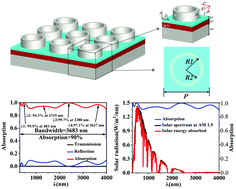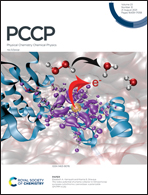Ultra-wideband and wide-angle perfect solar energy absorber based on Ti nanorings surface plasmon resonance
Abstract
Solar energy absorption is a very important field in photonics. The successful development of an efficient, wide-band solar absorber is an extremely powerful driver in this field. We propose an ultra-wideband (UWB) solar energy absorber composed of a Ti ring and SiO2–Si3N4–Ti thin films. In the range of 300–4000 nm, the wide band has an absorption efficiency of more than 90% and can reach 3683 nm, and it has four absorption peaks with a high absorptivity. Moreover, the weighted average absorption efficiency of the solar absorber under AM 1.5 is maintained above 97.03%, which indicates it has great potential for use in the field of solar energy absorption. Moreover, we proved that the polarization is insensitive by analyzing the absorption characteristics at arbitrary polarization angles. For both the transverse electric (TE) and transverse magnetic (TM) modes, the UWB absorption is maintained at more than 90% in the wide incidence angle range of 60°. The UWB solar energy absorber has great potential for use in a variety of applications, such as converting solar light and heat into electricity for public use and reducing the side effects of coal-fired power generation. It can also be used in information detection and infrared thermal imaging owing to its UWB characteristics.



 Please wait while we load your content...
Please wait while we load your content...